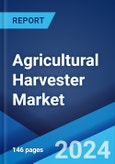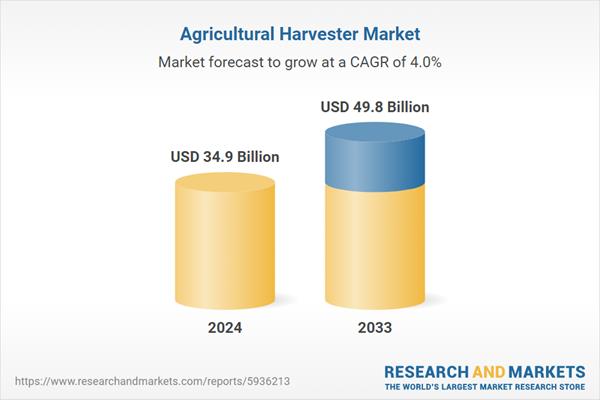Agricultural harvesters are employed by farmers to harvest grain crops. They perform three major tasks - reaping, threshing and winnowing. These harvesters are used to increase farm production in a short time and their utilization has proved to be better than conventional harvesting methods. Moreover, agricultural practices are steadily becoming dependent on machines and tools, such as harvesters, as they help to minimize farm drudgery, enhance productivity, lower crop production costs and significantly bring down harvest losses.
Market Trends
Several regions across the globe are experiencing a shortage of labor force which has led farmers to make a shift towards mechanization. In line with this, numerous governments are promoting the use of equipment to boost farm output. They are offering subsidies and necessary training to farmers which, in turn, is propelling the sales of these harvesters. Furthermore, vendors are consistently upgrading their equipment with telemetry and intelligent sensing technologies to enhance convenience and efficiency. Other new features such as GPS and navigation systems have also been incorporated in these harvesters to help in carrying out operations with more precision. Other factors driving the demand of harvesters include increasing food demand, rising rural incomes, increasing adoption of modern farming practices, etc.Market Segmentation
This report provides an analysis of the key trends in each sub-segment of the global agricultural harvester market report, along with forecasts at the global and regional level from 2025-2033. The report has categorized the market based on product type, drive type and application.Breakup by Product Type
- Combine Harvester
- Forage Harvester
Breakup by Drive Type
- Four-Wheel Drive Harvester
- Two-Wheel Drive Harvester
Breakup by Application
- Wheat
- Rice
- Maize
- Barley
- Others
Breakup by Region
- North America
- Asia Pacific
- Europe
- Middle East and Africa
- Latin America
Competitive Landscape
The report has also analysed the competitive landscape of the market with some of the key players being Deere & Company, CNH Industrial N.V., AGCO Corporation, CLAAS KGaA mbH, Mahindra & Mahindra Ltd., Maschinenfabrik Bernard Krone GmbH, Yanmar Holdings Co., Ltd., PÖTTINGER Landtechnik GmbH, Dewulf BV, Lovol Heavy Industry CO., LTD, Lely International N.V., Ploeger Machines BV, PREET AGRO Industries (P) Limited, SDF S.p.A., and Sampo Rosenlew Ltd.Key Questions Answered in This Report
1. What was the size of the global agricultural harvester market in 2024?2. What is the expected growth rate of the global agricultural harvester market during 2025-2033?
3. What are the key factors driving the global agricultural harvester market?
4. What has been the impact of COVID-19 on the global agricultural harvester market?
5. What is the breakup of the global agricultural harvester market based on the product type?
6. What is the breakup of the global agricultural harvester market based on the application?
7. What are the key regions in the global agricultural harvester market?
8. Who are the key players/companies in the global agricultural harvester market?
Table of Contents
Companies Mentioned
- Deere & Company
- CNH Industrial N.V.
- AGCO Corporation
- CLAAS KGaA mbH
- Mahindra & Mahindra Ltd.
- Maschinenfabrik Bernard Krone GmbH
- Yanmar Holdings Co. Ltd.
- PÖTTINGER Landtechnik GmbH
- Dewulf BV
- Lovol Heavy Industry CO. Ltd.
- Lely International N.V.
- Ploeger Machines BV
- PREET AGRO Industries (P) Limited
- SDF S.p.A.
- Sampo Rosenlew Ltd.
Methodology

LOADING...
Table Information
| Report Attribute | Details |
|---|---|
| No. of Pages | 142 |
| Published | February 2025 |
| Forecast Period | 2024 - 2033 |
| Estimated Market Value ( USD | $ 34.9 Billion |
| Forecasted Market Value ( USD | $ 49.8 Billion |
| Compound Annual Growth Rate | 4.0% |
| Regions Covered | Global |
| No. of Companies Mentioned | 15 |









